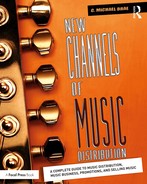13
International Markets
The Internet has just leveled the playing field as every global market is now within reach!
International Music Records Popular in Japanese Marketplace
The United States purchases more music products than any other country in the world. Second to the United States in the music purchasing market is the country of Japan, according to Ben Sisario of the New York Times (Hutchison et al., 2010). The Japanese purchase roughly 25% of all foreign records and music products in the world. To give you some perspective on this, more than $1 billion is spent by the Japanese on foreign music products from other countries. When it comes to all the CD albums sold in Japan, 25% of them contain foreign music on them. Therefore, if you create your own music and wish to find a suitable marketplace to sell it in, then try selling it in Japan because you may find a lot of interested buyers there.
The Japanese may be second to American in purchasing foreign music, but the average Japanese citizen spends more money to purchase this music than the average American citizen (Peoples, 2015). One of the primary methods of music purchasing in Japan is through the Internet. Out of all the digital music products purchased in Japan, 82% of them are online downloadable products that the Japanese listen to on their laptops, tablets or smartphones. In fact, 18% of these music purchases in Japan are just on mobile phones alone.
Japanese music lovers enjoy a variety of music genres. They listen to everything from reggae to hiphop to alternative rock. You name it, they listen to it (JMM, 2016). About one in every four CD albums sold in Japan is international (Miller, 2014). What you may not realize is that Japan actually has a bigger population than a lot of other countries in the world. And since they are becoming a little more “westernized” and developed, they are more open to having foreign influences like music in their marketplaces.
Despite all the digital music purchases, some Japanese still prefer the physical CDs for their music. In fact, 78% of the total music sales in Japan are still physical CDs. This is kind of surprising for a developing country that has digital streaming options available. Compare this to a country like Sweden, which has most of their music sales from digital streaming, and you will be very amazed.
In 2006, 89 US outlets for the music company Tower Records had closed down. However, there are still 85 outlets of this company in Japan and they are managed by the biggest phone carrier in the country, which is NTT DoCoMo. With all these outlets being successful, they rake in $500 million in profits each year. Go figure!
CD sales have plummeted over the last 5 to 10 years, forcing many physical record stores to close down. The reason is because more consumers are turning to the Internet to purchase music. When you advertise your music merchandise, the advertisement should specify the URL address of a Japanese website where they can go to purchase music. If you are not in Japan and would rather keep it localized for Japanese consumers, provide the URL addresses of Japanese music stores where your music products are being sold, whether they’re just merchandise, physical CDs and/or digital music downloads.
Global Consumers Are Buying More Online
According to a polled survey of 30,000 online respondents in 60 countries, more than half of global consumers are willing to buy products online (Nielsen, 2015).
The survey was conducted to understand how digital technology will shape the retail landscape of the future, according to Nielsen Global e-commerce and the New Retail Survey. One-quarter of global respondents say they are already ordering retail products online for home delivery and more than half (55%) are willing to use do so in the future (Nielsen, 2015).
The report looks at how consumers are using technology and offers insights into how retailers and manufacturers can use flexible retailing options to improve the shopping experience and drive increased visitation and sales across channels.
Connected Commerce: Bridging Digital With the In-Store Experience

Figure 13.1 International Market
The good news for brick-and-mortar retailers is that clicks won’t be replacing bricks any time soon. Online shopping has a number of benefits, but physical stores also have strong key advantages over e-commerce—especially for fast-moving consumer goods. In fact, the majority of global respondents (61%) reported that going to a physical store is an enjoyable and engaging experience. A similar percentage (57%) think that shopping in a retail store is a fun day out for the family (Coupe, 2015).
However, Nielsen research shows that clicks do lead to bricks and this is an important take-away for retailers and manufacturers who must engage the consumer early on the path to purchase.
Who Is Shopping Online?
The growth of online CPG (consumer packaged goods) sales has been driven in part by the maturation of digital natives, the consumers who grew up with digital technology (the Millennials and now Generation Z). These consumers have an unprecedented enthusiasm for and comfort with technology, and online shopping is a deeply ingrained behavior. Current usage of six e-commerce options (home delivery, in-store pickup, drive-through pickup, curbside pickup, virtual supermarket and automatic subscription) is greatest among the youngest respondents, and they are also the most willing to use all of the e-commerce options in the future. Andrew McCaskill of Nielsen, states in his article “More Than Half of Global Consumers Are Willing to Buy Groceries Online” that 30% of Millennials (ages 21–34) and 28% of Generation Z (ages 15–20) respondents say they’re ordering groceries online for home delivery, compared with 22% of Generation X (ages 35–49), 17% of Baby Boomers (ages 50–64) and 9% of Silent Generation (ages 65+) respondents. Younger respondents are also the most willing to use all of the e-commerce options in the future (Nielsen, 2015).

Figure 13.2 Young Lady Lifestyle
According to the Nielsen Global Retail Format Preferences Survey, Patrick Dodd, a Nielsen spokes-person mentioned:
Millennials are at the beginning of their careers and are starting to form households, while the oldest members of Generation Z will soon be graduating college and joining the workforce. These generations will shape our economy for decades to come. Therefore, it is critical that retailers and manufacturers understand how these consumers are using technology and include digital touch points along the entire path to purchase.
(Nielsen, 2015)
Willingness to use digital retailing options in the future is highest in the developing markets in the Asia-Pacific (60% on average), Latin America (60%) and Africa/Middle East regions (59%), and trails in Europe (45%) and North America (52%). Continued increases in mobile adoption and broadband penetration, particularly in the developing regions, have also helped boost online grocery sales. Regionally, Asia-Pacific consistently exceeds the global average for adoption of all online retailing options. Ordering online for home delivery is the most commonly preferred flexible retailing option in the region, with particularly high usage in China. More than one-third (37%) of Asia-Pacific respondents, and even more in China (46%), say they use an online ordering and delivery service. Adoption levels for online automatic subscriptions are also particularly high in this region (22% versus 14% globally), with China once again leading the way (30%) (Nielsen, 2015).
While digital is here to stay, the majority of consumers will continue to shop for the bulk of their purchases in-store—even if the channels they’re using are changing. Shoppers will use whatever format best suits their needs for convenience, choice and value. Therefore, it is critical that retailers and manufacturers leverage physical and digital assets to optimize the in-store experience.
Understanding International Environments
Releasing music or product in an international market requires planning. Simply releasing a digital music album or CD doesn’t ensure economic benefit nor does it promise a beneficial and sustainable career in country X. Your goal, simply put, should be to strategically boost a career plan and sell albums over a long period of time. A few tips I suggest are:
1. Understand the Design Differences
Study the album trends in a specific region of release before blindly putting out a product. US statistics reveal that 90% of albums use photography of the group/band/musician; the three most commonly used colors are black, blue and white; and only 10% use artistic graphics. However, what works here in the US in terms of colors may not work in another country (Alleyne, 2014).
2. Use Local Musicians to Gain Recognition
Collaborate and use a local musician from another country in an attempt to cross over markets. With the overwhelming amount of indie level bands craving crossover and international exposure, partnering with other musicians should prove easy.
3. Understand Distribution Outlets
What works in big box retail storefronts in America does not work the same way in another country. Pay close attention to the popular distribution outlets, whether it be large music stores, digital sales or mom and pop stores. Another sensible approach is to set up nontraditional retailer relationships. International groups have a certain appeal, mysteriousness and draw where nontraditional retail stores may be interested in a partnership. Locate stores and specialty stores that may complement your style of music and then establish contact.
Conclusion
The music business is in a constant flux. There is no quick fix and/or solution overnight. What is sure is “brand positioning” in which music buyers all over the world view, perceive and engage your specific artist, music and label. Your overall goal is to have your music in every channel possible throughout the world. Music is universal and the Internet is your avenue to fuel and fulfill your dreams. I am in hopes that this book is able to take you a step closer in understanding all the alternatives and strategies possible in selling your music.
References
Alleyne, M. (2014). After the Storm: Hipgnosis, Storm Thorgerson, and the Rock Album Cover: Rock Music Studies. Rock Music Studies, 1 (3), 251–267. Retrieved from www.tandfonline.com/doi/full/10.1080/19401159.2014.949553
Coupe, K. (2015). Study: Consumers Increasingly Willing to Shop Online for Groceries—MorningNewsBeat. Morningnews-beat.com. Retrieved 27 September 2016, from www.morningnewsbeat.com/News/Detail/46923/2015-05-04/
Hutchison, T., Macy, A., & Allen, P. (2010). Record Label Marketing. Burlington, MA: Focal Press.
JMM. (2016). Japan Music Marketing—Create a Japanese Website and Mobile Site. Japanmusicmarketing.com. Retrieved 27 September 2016, from http://japanmusicmarketing.com/
Miller, K. (2014). Japan Overwhelmingly Favors CDs to Digital Music ‹ Japan Today: Japan News and Discussion. Japantoday.com. Retrieved 27 September 2016, from www.japantoday.com/category/entertainment/view/japan-overwhelmingly-favors-cds-to-digital-music
Nielsen, M. (2015). More Than Half of Global Consumers Are Willing to Buy Groceries Online. Nielsen.com. Retrieved 27 September 2016, from www.nielsen.com/pk/en/press-room/2015/more-than-half-of-global-consumers-are-willing-to-buy-groceries-online.html
Peoples, G. (2015). Japanese Digital Music Revenues Up 5 Percent. Billboard. Retrieved 27 September 2016, from www.billboard.com/articles/business/6671304/japanese-digital-music-revenues-up-5-percent
